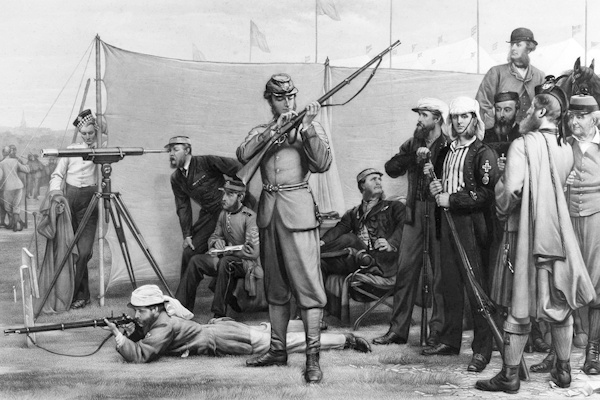You are here: Home > Marksmanship > 19th Century Riflemen > England > William Metford
Source: Minutes of Proceedings of the Institution of Civil Engineers, Volume 140, 1900
Civil Engineer > Rifle Work
William Ellis Metford was the elder son of William Metford MD of Flook House, Taunton, by his marriage with Miss M E Anderdon, and was born on October 4th, 1824. He was educated at Sherborne and afterwards became a pupil of Mr W M Peniston, then Resident Engineer under Mr Brunel on the Bristol and Exeter Railway, and from 1846 to 1850 was employed under Mr Brunel on the Wilts, Somerset and Weymouth Railway. He subsequently worked for Mr T E Blackwell in connection with schemes for developing the traffic of Bristol and afterwards for a short time acted as engineer under Mr Peniston who was contractor for the Wycombe Railway.
During this period of his life he made many friends in the profession and in 1855 became acquainted with Mr William Froude who at once recognised his ability and skill and became his most intimate friend.
Mr Metford devised a form of theodolite with a traversing stage and a curved arm upholding the transit axis, which is described in the Proceedings of the Institution for February 1856. He also invented an improved level in which the upright stem of the level telescope terminated in a sphere resting on the lower plate of the level and gripped by a ring grip tightened by four screws pulling downwards and having spherical nuts. The instrument could then be adjusted accurately even if the plates were as much as 25 degrees out of the horizontal. Mr Froude suggested a further improvement – that the sphere should not rest on the bottom plate, but should have an internal hollow sphere resting upon a small sphere concentric with the outer sphere.
Early in 1857 Mr Metford, who had married a daughter of Dr Wallis of Bristol, obtained a very important appointment on the East Indian Railway under the present Sir Alexander Rendel. This he obtained largely through the recommendation of Mr Blackwell and Mr Brunel. He arrived at Monghyr, on the Ganges, in May of that year, the mutiny having just broken out. Here there was every probability of an outbreak; the town of 50,000 native inhabitants contained no troops but a handful of Sepoys belonging to a mutinied regiment. The Europeans, some seventy or eighty in all, were taking no active steps to organise defence. If they fled, as was possible by boat, the town would be given over to anarchy and violence. Mr Metford decided to remain and, with his railway staff, took in hand as well as he could the organisation of patrols and other repressive measures. His task was difficult, for he had no official position as leader. The old fort was ruinous and too large to be defended by so few; a house was accordingly fortifiedand provisioned in case of need. Patrols and guards were organised and it became known that ‘Metford Sahib’ was making explosive shells and other murderous inventions. Besides taking his turn on guard duty, he superintended every measure of defence and could scarcely rest night of day. It was the most trying part of the Indian hot weather and not until the beginning of August could English soldiers be spared to garrison the town. Had it not been for Mr Metford’s determination another massacre might have been added to the story of the Mutiny. The heroism of the man who prevented it has remained unrecognised and almost unknown.
The strain of this terrible time left him seriously ill – suffering from inflammation of the membrane lining of the brain – and after some months of rest and an attempt to resume his work at Monghyr he returned home after a little more than a year’s absence from England, and was obliged definitely to abandon the profession. Much of the work which he afterwards accomplished was done under the strain of continual depression and headache.
